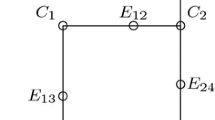Abstract
The hitchhiking effects of a selected locus upon the dynamics of the pairwise association,D nn between two neutral loci is examined analytically for the special case where at least one of the neutral loci is in linkage equilibrium with the selected locus. The results apply approximately whenever the product of the pairwise associations between the selected locus and each neutral locus is negligible with respect to the three-way linkage disequilibrium. It is shown that precisely four broad classes of trajectories are possible, whether the selected locus is between (nsn) or to one side (snn) of the neutral loci, and whatever the mode of selection operating.D nn may: (1) decay rapidly to zero, at a rate faster in each generation than that expected for two isolated neutral loci; (2) monotonically decay to zero at a rate which is slower in every generation than under the usual neutral regime; (3) increase initially and/or in intermediate periods before eventually slowly decaying to zero; or (4) exhibit type 1 behavior in the first segment of the trajectory and either type 2 or 3 behavior in the subsequent generations, with the transition marked by a change in sign. The nature of a given trajectory is largely determined by the direction of gene frequency change at the selected locus, and the initial signs of bothD nn and the three-way linkage disequilibrium.
The single most important consequence of these results is that there is no simple relation between the amount of pairwise association between two neutral markers and the recombination fraction between them. Several factors influencing the magnitude of the hitchhiking effect are also examined. It is shown that, all else being equal, the greater the three-way linkage disequilibrium, the greater the departure ofD nn from the expected neutral dynamic. Increased recombination among the loci reduces the hitchhiking effect onD nn . The dependence of the behavior upon the exact position of the selected locus is also determined both within and betweennsn andsnn chromosomal systems. An interesting discovery is that given equivalentnsn andsnn systems, with each having the same recombination between their two neutral loci,D nn will deviate more from the standard neutral dynamic in thesnn system if its selected locus is sufficiently tightly linked to the neutral loci.
Similar content being viewed by others
References
Antonarakis, S. E., Boehm, C. D., Giardina, P. J. V., Kazazian, H. H., Jr.: Nonrandom association of polymorphic restriction sites in the β-globin gene cluster. PNAS79, 137–141 (1982a)
Antonarakis, S. E., Orkin, S. H., Kazazian, H. H. et al.: Evidence for multiple origins of the β-globin gene in Southeast Asia. PNAS79, 6608–6611 (1982b)
Asmussen, M. A.: Dynamics of the interlocus associations in the three locus hitchhiking model. 1. The three-way linkage disequilibrium function. J. Math. Biol.23, 285–304 (1986)
Asmussen, M. A., Clegg, M. T.: Dynamics of the linkage disequilibrium function under models of gene frequency hitchhiking. Genetics99, 337–356 (1981)
Asmussen, M. A., Clegg, M. T.: Rates of decay of linkage disequilibrium under two-locus models of selection. J. Math. Biol.14, 37–70 (1982)
Barker, D., Holm T., White, R.: A locus on chromosome 11p with multiple restriction site polymorphisms. Am. J. Hum. Genet.36, 1159–1171 (1984)
Bech-Hansen, N. T., Linsley, P. S., Cox, D. W.: Restriction fragment length polymorphisms associated with the immunoglobulinC γ genes reveal linkage disequilibrium and genome organization. PNAS80, 6952–6956 (1983)
Chakravarti, A., Buetow, K. H., Antonarakis, S. E., Waber, P. G., Boehm, C. D., Kazazian, H. H.: Nonrandom recombination within the human β-globin gene cluster. Am. J. Hum. Genet.36, 1239–1258 (1984a)
Chakravarti, A., Phillips III, J. A., Mellits, K. H., Buetow, K. H., Seeburg, P. H.: Patterns of polymorphism and linkage disequilibrium suggest independent origins of the human growth hormone gene cluster. PNAS81, 6085–6089 (1984b)
Clegg, M. T.: Dynamics of multilocus systems under selection. In: Dawkins, R., Ridley, M. (eds.) Oxford surveys in evolutionary biology, Vol. 1, pp. 160–183. Oxford University Press, Oxford 1984
Eng, C. E. L., Strom, C. M.: Analysis of three restriction fragment length polymorphisms in the human type II procollagen gene. Am. J. Genet.37, 719–732 (1985)
Gusella, J. F., Wexler, N. S., Conneally, P. M., Naylor, S. L. et al: A polymorphic DNA marker genetically linked to Huntington's disease. Nature106, 234–238 (1983)
Lidsky, A. S., Ledley, F. D., DiLella, A. G. et al.: Extensive restriction site polymorphism at the human phenylalanine hydroxylase locus and application in prenatal diagnosis of phenylketonuria. Am. J. Hum. Genet37, 619–634 (1985)
Migone, N., Feder, J., Cann, H. et al.: Multiple DNA fragment length polymorphisms associated with immunoglobulin μ-switch like regions in man. PNAS80, 467–471 (1983)
Murray, J. M., Davies, K. E., Harper, P. S., Meredith, L., Mueller, C. R., Williamson, R.: Linkage relationship of cloned DNA sequence on the short arm of theX chromosome to Duchenne muscular dystrophy. Nature300, 69–71 (1982)
Murray, J. C., Mills, K. A., Demopulos, C. M., Hornung, S., Motulsky, A. G.: Linkage disequilibríum and evolutionary relationships of DNA variants (restriction fragment length polymorphisms) at the serum albumin locus. PNAS81, 3486–3490 (1984)
Owerbach, D., Nerup, J.: RFLP of the insulin gene in diabetes mellitus. Diabetes31, 275–277 (1982)
Schmidtke, J., Pape, B., Krengel, U., Langenbeck, U., Cooper, D. M., Breyel, E., Mayer, H.: Restriction fragment length polymorphisms at the human parathyroid hormone gene locus. Hum. Genet.67, 428–431 (1984)
Thomson, G.: The effect of a selected locus on linked neutral loci. Genetics85, 753–788 (1977)
Wainscoat, J. S., Higgs, D. R., Kanavakis, E., Cao, A., Georgiou, D., Clegg, J. B., Weatherall, D. J.: Association of two DNA polymorphisms in the α-globin gene cluster: implications for genetic analysis. Am. J. Hum. Genet.35, 1086–1089 (1983)
Author information
Authors and Affiliations
Rights and permissions
About this article
Cite this article
Asmussen, M.A. The dynamics of interlocus associations in the three-locus hitchhiking model. J. Math. Biology 24, 361–380 (1986). https://doi.org/10.1007/BF01236887
Received:
Issue Date:
DOI: https://doi.org/10.1007/BF01236887




